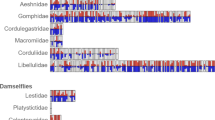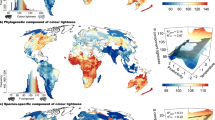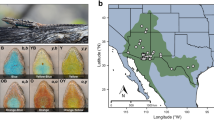Summary
The nature of the selective forces operating on M. unipunctatus abdominal colour morphs are examined using two forms of multiple regression analysis, one based upon 11 environmental variables measured at 42 localities in northern England, the other on five principal components generated from them. Results point to the importance particularly of visual selection by predators for crypsis but also of climate.
Aviary and mark release recapture experiments, although not statistically significant, provide direct evidence that birds predate M. unipunctatus with regard to their cryptic efficiency. In both experiments more dark than light insects were taken on lichen-covered rural branches while the reverse, i.e. more light than dark insects taken on lichen-free urban branches, was evident in field experiments only.
Comparisons of morph developmental rate in the field suggest that climatic selection may operate differentially upon the two morphs since dark adult females are heavier than light ones during the pre-oviposition period at the four localities sampled in Yorkshire.
The abdominal colour polymorphism appears to be stable in Yorkshire at present and two systems by which it may be maintained are discussed.
Similar content being viewed by others
Article PDF
References
Allison, A C. 1956. The sickle-cell and haemoglobin C genes in some African populations. Ann Hum Genet, 21, 67–89.
Anon. 1963. The Atlas of Britain and Northern Ireland (planned and directed by D. P. Bick-more and M. A. Shaw). Clarendon Press, Oxford.
Bishop, J A, and Cook, L M. 1975. Moths, melanism and clean air. Scient Am, 232, 90–99.
Broadhead, E. 1958. The psocid fauna of larch trees in northern England—an ecological study of mixed species populations exploiting a common resource. J Anim Ecol, 27, 217–263.
Cain, A J. 1965. Recent population studies on Cepaea at Oxford. Proc First Europ Malac Congr, London 1962, 209–213.
Cain, A J, and Currey, J D. 1963. Area effects in Cepaea. Phil Trans Roy Soc Lond, B, 246, 1–81.
Cain, A J, and Currey, J D. 1968. Climate and selection of banding morphs in Cepaea from the climate optimum to the present day. Phil Trans Roy Soc Land, B, 253, 483–498.
Clarke, C A, and Sheppard, P M. 1966. A local survey of the distribution of industrial melanic forms of the moth Biston betularia and estimates of the selective value of these in an industrial environment. Proc R Soc, B, 165, 424–439.
Ford, E B. 1971. Ecological Genetics. Chapman and Hall, London.
Lees, D R, and Creed, E R. 1975. Industrial melanism in Biston betularia: the rôle of selective predation. J Anim Ecol, 44, 67–83.
Lewontin, R C. 1974. The Genetic Basis of Evolutionary Change. Columbia University Press, New York and London.
Nie, N H, Bent, D H, and Hull, C H. 1970. Statistical Package for the Social Sciences. McGraw-Hill, New York.
Popescu, C, Broadhead, E, and Shorrocks, B. 1978. Industrial melanism in Mesopsocus unipunctatus (Müll.) (Insecta: Psocoptera) in northern England. Ecological Entomology, 3, 209–219.
Steward, R C. 1977. Melanism and selective prédation in three species of moths. J Anim Ecol, 46, 483–496.
Wapshere, A J. 1960. Studies of Psocid Ecology in Larch Plantations. D.Phil, thesis, University Library, Leeds.
Warren Spring Laboratory. 1972. The Investigation of Air Pollution. Annual Summary, April 1972-March, 1973.
Author information
Authors and Affiliations
Rights and permissions
About this article
Cite this article
Popescu, C. Natural selection in the industrial melanic psocid Mesopsocus unipunctatus (Müll.) (Insecta: Psocoptera) in northern England. Heredity 42, 133–142 (1979). https://doi.org/10.1038/hdy.1979.17
Received:
Issue date:
DOI: https://doi.org/10.1038/hdy.1979.17



